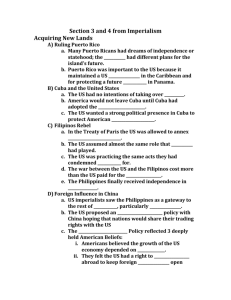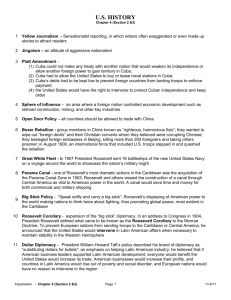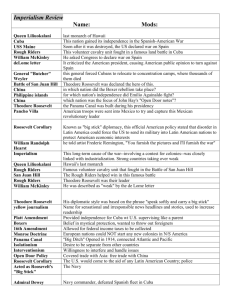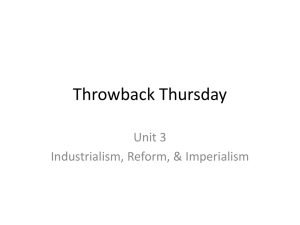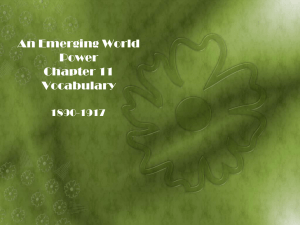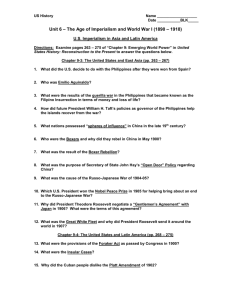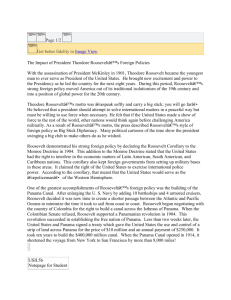America Claims an Empire 1890-1920
advertisement
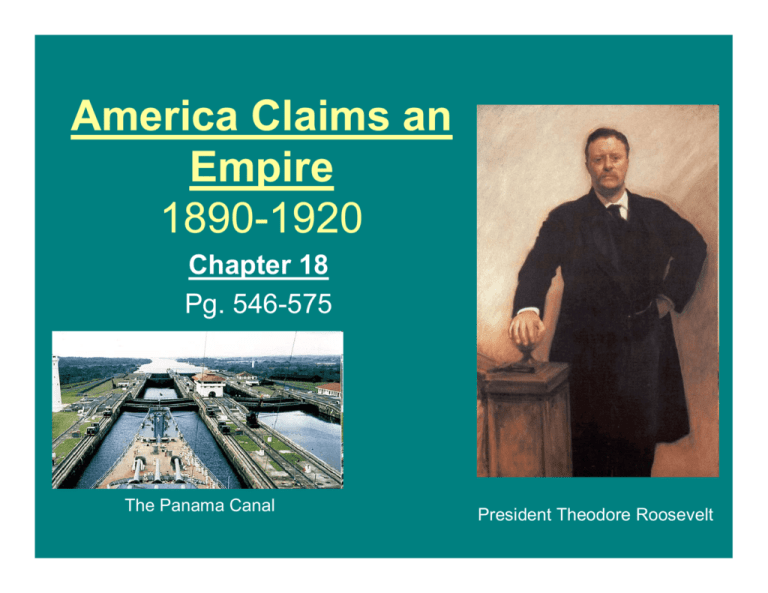
America Claims an Empire 1890-1920 Chapter 18 Pg. 546-575 The Panama Canal President Theodore Roosevelt The Age of Imperialism • The period between 1870 and 1914 has often been called the Age of Imperialism. • Imperialism is the policy of powerful countries seeking to control the economic and political affairs of weaker countries or regions. • During this period the United States and Japan became the imperial powers. • One reason for the growth of imperialism is because industrial nations of Europe want to raw materials from Africa and Asia. • Imperialism had other causes. Many Europeans believe they had a duty to spread their religion and culture to people to whom they consider to be less civilized. Exp ans ioni sm i sm n o ati l o Is Origins of Imperialism • In his farewell address, George Washington had advised the nation to steer clear of permanent alliances. He urged Americans to have as little possible connections with our foreign nations. This policy was called isolationism, or having to little to do with the political affairs of other nations. • Earlier In his career George Washington followed a policy of expansionism, or extending its national boundaries. Americans further pressed further westward to settle. • American factories turned out huge amounts of steel and other goods. The nation was growing rapidly, and arguments in favor of expansion held great appeal. • Expansionists also argued that the Americans had a right and a duty to bring western culture to the uncivilized peoples of the world. • Other expansionists stressed the need to offset the vanishing frontier by gaining European land. w Ne • Desire for military strength • Thirst for new markets • Belief in cultural superiority Ma rk et s 3 Factors fueled American Imperialism Cultural Superiority Military Strength Factor #1 Desire for Military Strength • Captain Alfred Mahan, of the United States Navy, argued that the United States needed a larger navy to protect American merchant ships. • A bigger navy would need more bases throughout the world. • Congress had begun to enlarge the modernized the navy. New steam hulled ships were being built. • The navy ships were called the Great White Fleet because they were painted white. Factor #2 Thirst for New Markets • • • • • • The Purchase of Alaska In the,1860’s the Secretary of the State, William Seward wanted the United States to dominate trade in the Pacific in 1867. He persuaded Congress to annex (add) the Midway Island. In this way the island became part of the United States. Russia in the 1800’s owned Alaska. Seward was playing a card game with the Czar and he offered to sell and Alaska for $7.2 million dollars to the United States. The land cost of 2¢ per acre. Most Americans called this purchase “Seward’s Folly”. They called this land the “icebox.” New Markets Con’t. • The United States took part of the island of Samoa. The people of Samoa had little say in the matter. • The United States demonstrated they have power in the lands of the Pacific Ocean. • Soon afterwards the Americans took the land called Hawaii from the King Kalakaua. When he died his sister, Queen Liliuokalani came to the throne. • She resented the Americans that settled in Hawaii. Faced with American guns, Liliuokalani give up her throne. • She wrote a protest to the United States government. New markets Con’t. • By acquiring Hawaii and Samoa, the United States gained important footholds in the Pacific. • Rivalry among the industrial nations was very dominant. • China had once been the most advanced empire in the world, however, years of civil war weakened the empire. In addition, China failed to industrialize as other nations have in the 1800’s. Britain, France, Germany, Russia, and Japan carved spheres of influence in China. A sphere of influence is an area, usually near seaport and run by a nation. The sphere had special trading privileges. The Spanish-American War • In 1895, the Cuban people rebelled against Spanish rule. Jose Marti, a Cuban poet and journalist was in support of a Cuban independence movement. • He organized Cuban resistance against Spain using an active guerrilla campaign. • Americans invested more than $50 million in the island of Cuba. American trade with Cuba was worth about $100,000,000.00 a year. • U.S. opinion was split over whether the United States should intervene in Cuba. Jose Marti War Fever Escalates… • William Randolph Hearst used yellow journalism, or sensational stories that were often biased or untrue to anger Americans and to urge the U.S. to declare war against Spain. • Hearst said, “you furnish the pictures and I’ll furnish the war.” War Escalates Con’t…. • In 1898, fighting broke out in Havana, the Cuban capital. • President McKinley sent the battleship Maine to Havana to protect the American citizens there. • On February 15, a huge explosion ripped through the ship. The explosion killed at least 260 of the 350 sailors and officers on board. • Yellow journalists used the explosion to push the Americans into the war in Cuba. The real cause of the explosion remains a mystery today. Hearst’s Yellow J ournalism Headline Battleship U.S.S. Maine The battleship Maine after explosion… The battleship Maine before explosion…. War is Declared!! Theodore Roosevelt • On April 20, 1898 President McKinley declared war on Spain. • This war was called the Spanish-American War. The Spanish-American war lasted only four months. • The navy Secretary, Theodore Roosevelt, felt it was important to attack the Spanish in the Philippines as soon as the war began. • George Dewey, commander of the Pacific fleet followed Roosevelt’s instructions immediately after war was declared. George Dewey Theodore Roosevelt • Meanwhile, American troops had landed in Cuba. • None were more eager than Theodore Roosevelt. Roosevelt organized The First Volunteer Cavalry Regiment, later called the Rough Riders. • During the battle for the city of Santiago, Roosevelt led the rough riders in charge of the San Juan Hill. • This battle was called The Battle of San Juan Hill. American troops were successful in taking the hill. • • • • • • • • Two days later, the Americans destroyed the Spanish fleet in Santiago Bay. The Spanish army in Cuba surrendered. American troops then landed on Puerto Rico and claimed the island. Spain then agreed to sign an armistice, thus ending the fighting. In a peace treaty signed in Paris in December of 1898, Spain agreed to grant Cuba its freedom as well as turn the islands of Guam and Puerto Rico to the U.S. The U.S also acquired the Philippines by purchasing it for $20 million dollars. After the war, American soldiers remained in Cuba while the nation debated who would rule. In the end, the United States let the Cuban people write their own constitution. However, Cuba had to accept the Platt Amendment. The amendment allowed the United States to intervene in Cuba and gave the United States control of the naval base in Guantá Namo Bay. In effect, the amendment made Cuba an American protectorate, a nation whose independence is limited by the control of a more powerful country. Orville Platt, sponsor of the Platt Amendment Foreign Influence in China • • • • • • U.S imperialists saw the Philippines as a gateway to the rest of Asia, specifically to China. China was weakened by war and foreign influence was already carved into Spheres of Influence or an area where a nation claimed special rights and economic privileges. In fear that China would be colonized by other countries, the U.S. encouraged an open door policy in China. Under the policy, all nations could trade with one another in China. Many Chinese opposed foreign influences in the country. These people were called the boxers. In 1900, the boxers rebelled. They attacked farmers in China. They killed more than 200 people. Americans armed with modern weapons stopped the boxer’s and freed all the captives that they held. This is called the Boxer Rebellion. The U.S. in Latin America • • • • • • When Theodore Roosevelt became President in 1901, he was determined to build a canal through the Isthmus of Panama. An Isthmus in a narrow strip of land connecting larger bodies of land. Panama was the perfect place for canal because of its location. Roosevelt knew that a canal would greatly benefit the American commerce and military capability. It would also reduce the cost and shipping goods. A revolution between Columbia and Panama began. The people of Panama revolted against the Columbian’s this made it very hard for Roosevelt to build the isthmus. Soon, Panama won their independence from Columbia. The United States recognized the new nation. Panama then agreed to let the United States build a canal. • In building the Canal, tropical heat and mosquitoes made it very difficult. • Two tropical diseases were very common; Yellow Fever and Malaria. • Under the supervision of army engineer Colonel George Geothals, more than 40,000 workers struggled to dig the canal. • Finally in 1914, the first coach and steamship traveled through the Panama Canal. Roose ve softly a lt: “Speak n stick.” d carry a big • In 1904, Roosevelt announced an important addition to the Monroe Doctrine, which demanded that European countries stay out of the affairs of Latin American nations. • In the Roosevelt Corollary, he claimed the right of the United States to intervene in Latin America to preserve law and order. • Roosevelt successor, William Howard Taft, also favored a strong American role in Latin America. • He urged American bankers to invest in Latin America. This policy of building strong economic ties to Latin America became known as the dollar diplomacy. • American investors responded eagerly. They helped build roads, railroads, and harbors in Latin America. • Woodrow Wilson, elected President in 1912, disliked the heavy handed foreign policies of his past predecessors. • He proposed instead a policy of missionary diplomacy. Wilson’s goals were to condemn imperialism, spread democracy, and promote peace in Latin America. Relations with Mexico • • • • • • Mexican President Diaz was the Mexican President from 1884 to 1911 and he welcomed American investments. Meanwhile, most Mexicans remained poor. These harsh conditions led to widespread discontent. In 1910, Mexicans rebelled against Diaz. Francisco “Pancho” Villa led the resistance in a Civil War in Mexico. To capture Villa, President Wilson sent General John J. Pershing with an army of several thousand soldiers. In 1917, after failing to capture Villa, Wilson ordered Pershing’s army to withdraw. “Pancho” Villa Ge n era l Pe rsh ing Causes Effects • Economic competitions among industrial nations. • Political and military competition, including the creations of a strong naval forces • A belief in Anglo-Saxon superiority • U.S. purchased Alaska in 1867. • U.S annexed Hawaii in 1898. • In, 1898, the U.S. helped Cuba win independence from Spain. • In the Treaty of Paris, the U.S gained Puerto Rico, Guam, and the Philippine Islands. Effects continued onto next slide….. • Following the Spanish-American War, the U.S.: – Reorganized the government of Puerto Rico – Established a protectorate over Cuba – Crushed a revolt in the Philippines • In 1889, the Open Door Policy established U.S. trading rights in China. • In the early 1900s, Roosevelt initiated plans for the Panama Canal and asserted the right of the U.S. to exercise police power in the Western Hemisphere. • Wilson, pressured Mexico and other countries in the Western Hemisphere to establish democratic governments.
